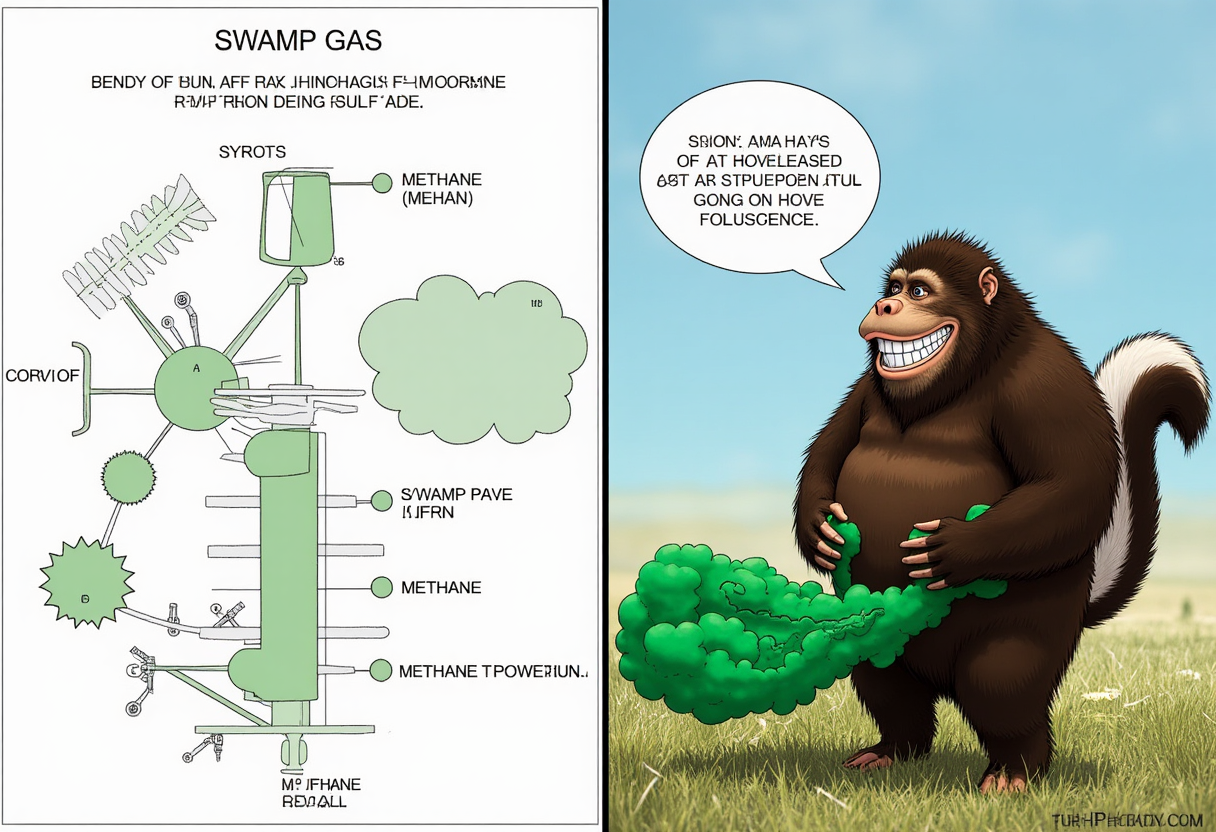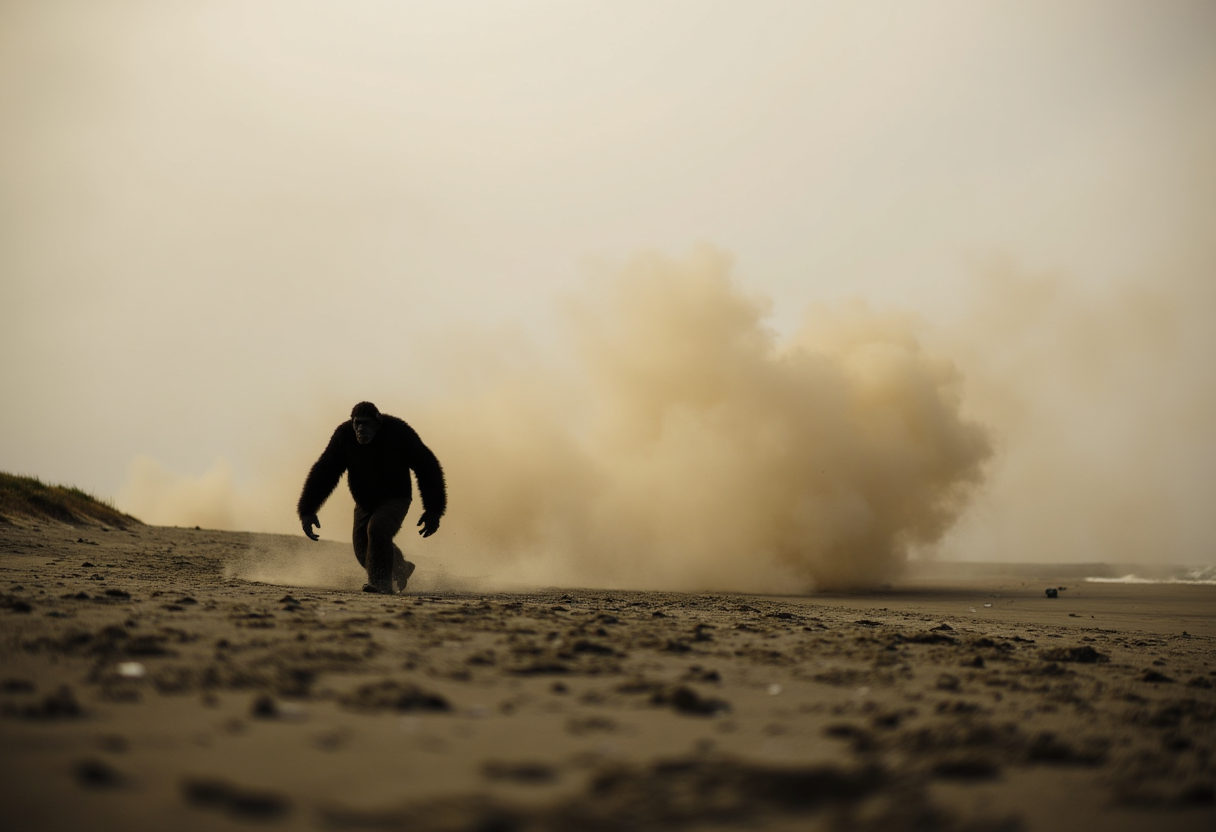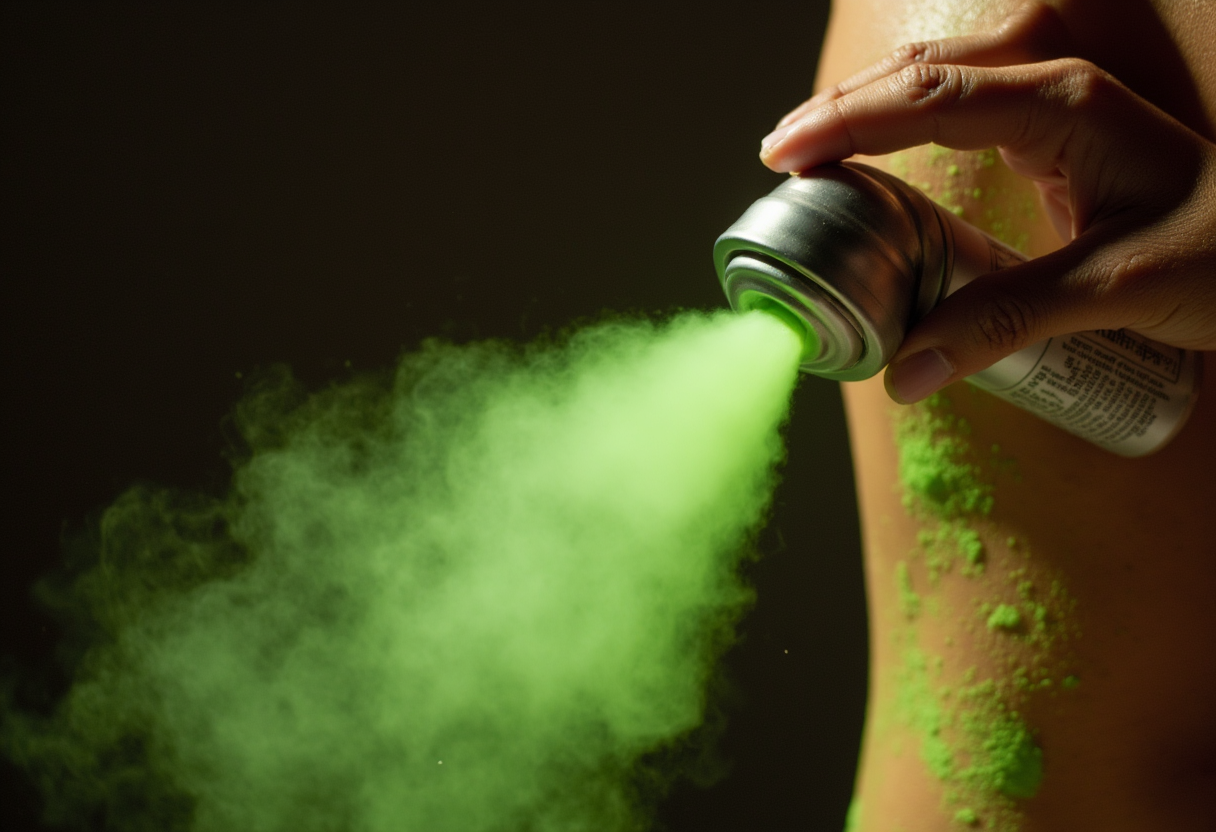The Unexplained Stench: Is Florida’s Skunk Ape More Than Just a Myth?
"A split-screen image: on one side, a scientific diagram explaining 'swamp gas' (methane, hydrogen sulfide), looking very sterile and rational. On the other side, a whimsical, almost cartoonish illustration of a Skunk Ape with a mischievous grin, holding its stomach as if having just released a powerful, visible green cloud of gas,
It clings to the air like a humid blanket after a summer storm, a pungent, unmistakable aroma that can clear a crowded beach faster than a shark alarm.
We're not talking about your Uncle Larry's post-chili night.
We're talking about that smell. The one whispered about in hushed tones around Florida campfires, blamed on everything from rotting vegetation to particularly ambitious alligators.
But what if we told you that lingering, sulfurous cloud, often accompanied by inexplicable mishaps, isn't just swamp gas?
What if it's the signature scent of Florida's most elusive, most malodorous, and quite possibly, most comically disruptive cryptid: the Skunk Ape?
Beyond the Bigfoot: Unmasking the Florida Skunk Ape (and Its Unfortunate Digestive Habits)
For decades, the dense, verdant expanse of the Florida Everglades has been a cauldron of mystery. Tourists flock to glimpse its unique wildlife – the alligators, the panthers, the myriad of exotic birds.
But local legends, passed down through generations of cracker families and curious naturalists, speak of something else entirely.
Something bipedal, ape-like, and profoundly… fragrant. This is the realm of the Skunk Ape, Florida’s very own answer to Bigfoot, yet with a distinct, undeniable difference: it carries its potent brand of aromatic identification.
While Bigfoot sightings often focus on blurry photos and fleeting glimpses, the Skunk Ape provides a more visceral experience.
It’s not just seen; it’s smelled.
And it's this very characteristic that has led to a fascinating, and frankly hilarious, subgenre of Florida cryptid lore. Forget menacing monsters of the deep; we’re talking about a legendary beast whose most potent weapon might be its digestive system.
"A dark, blurry silhouette of a large, ape-like creature, seen just before dawn, lumbering away from sand dunes on a deserted stretch of South Beach.
A Whiff of Evidence: When the Skunk Ape's Passage Causes a Public Fiasco
The purported sightings of the Skunk Ape stretch back decades, interwoven with the fabric of Florida legends.
From the cypress swamps of Collier County to the remote islands of the Everglades, reports describe a creature resembling an orangutan,
approximately 6-8 feet tall, covered in reddish-brown fur, and possessing eyes that glow eerily in the moonlight.
But always, always, accompanying these descriptions is the overpowering stench – a mix of rotten eggs, stale marsh water, and something indefinably… funky.
What’s truly curious, however, are the anecdotal stories that tie this peculiar odor to sudden, inexplicable, and often embarrassingly public mishaps.
It's almost as if the Skunk Ape’s gaseous emissions have a direct, if temporary, impact on the very fabric of reality for those unfortunate enough to be in its vicinity.
Take, for instance, the infamous "Politician's Toupee Incident" of '97. During a particularly heated outdoor press conference in the humid heart of the Everglades,
A candidate was mid-sentence, passionately decrying property taxes, when a sudden, noxious gust of wind swept through the crowd.
Not only did several reporters visibly gag, but the politician's meticulously coiffed toupee lifted clean off his head, performing a slow, majestic pirouette before landing squarely in a nearby gator pond.
Witnesses swore they heard a faint, guttural chuckle from the dense undergrowth, followed by an immediate dissipation of the foul odor.
Coincidence?
Or the Skunk Ape’s mischievous sense of humor, perhaps fueled by a particularly robust meal of wild hogs and fermented swamp fruit?
Then there's the equally perplexing tale of the "Competitive Sunbather's Spray Tan Disaster" in South Beach. A self-proclaimed "tan-aholic" was meticulously applying her fourth layer of industrial-strength spray tan on a deserted stretch of sand, aiming for that perfect, bronzed glow.
A politician, mid-sentence, passionately gesticulates, but his meticulously coiffed toupee is caught mid-air, performing a slow, majestic pirouette due to an invisible noxious gust of wind. Several reporters in the background gag visibly, clutching their noses. A gator pond sits ominously in the foreground."
Suddenly, a wave of truly appalling stench washed over her. Within moments, the vivid orange-brown spray began to morph, shifting to an unnatural, sickly shade of luminous green, reminiscent of an algae bloom on a stagnant pond.
The poor woman spent the rest of the day desperately scrubbing, utterly baffled by the chemical reaction. Local folklore whispers that a large, hairy silhouette was seen lumbering away from the dunes shortly before the unfortunate incident.
leaving only a lingering aroma of bad decisions and worse digestion.
Is There a Scientific Explanation for the Skunk Ape's "Powers"?
Of course, skeptics are quick to offer rational explanations. Swamp gas, they say, is a real phenomenon, caused by decaying organic matter in marshy environments releasing methane and hydrogen sulfide.
Strong winds, they argue, can create sudden gusts. And human clumsiness, well, that's just a part of life.
But then, how do you explain the timing? The peculiar synchronicity between the noxious fumes and the specific, often ludicrous, misfortunes?
Is it possible that the Skunk Ape, if it exists, isn't just emitting a passive odor, but is somehow harnessing it?
Perhaps a heightened sense of smell allows it to detect human vulnerabilities, or its sheer emotional state (boredom? annoyance? post-meal satisfaction?) directly influences the gaseous output, turning it into a localized, atmospheric weapon of mild inconvenience.
Cryptozoology blogs and unexplained phenomena forums are rife with theories. Some suggest the Skunk Ape's diet is simply exceptionally high in sulfurous compounds.
Others theorize it's a defense mechanism, a truly repulsive "cloud of confusion" designed to deter humans and ensure its continued isolation. And then there are those who propose a more whimsical idea:
The Skunk Ape is simply an overgrown prankster, using its unique biological byproduct to entertain itself in the vast boredom of the Everglades. It's certainly a more amusing thought than just a shy, stinky ape.
"A close-up of a glamorous-looking spray tan bottle. As its contents are being applied to skin, the spray transforms from a rich bronzed color into a fluorescent, unnatural green mist,
Tracking the Elusive: The Unofficial Do's and Don'ts of Skunk Ape Encounters
While mainstream science largely dismisses the Skunk Ape as a figment of imagination or mistaken identity, the persistent sightings and compelling "stenches" keep the legend alive.
For those intrepid souls venturing into the heart of the Everglades mystery, here are some unofficial tips, just in case you stumble upon this legendary, yet highly aromatic, beast:
Do carry a strong air freshener: Not for defense, but for personal comfort. And perhaps a gas mask for extended encounters.
Don't bother with fancy cameras: Chances are, by the time you've recovered from the smell, the moment (and the mysterious creature) will be gone. Plus, the fumes might fog your lens.
Do observe from a distance: Not just for safety, but for your olfactory glands' sake.
Don't offer it Tums: While tempting, offering antacids to an unknown cryptid is generally frowned upon by cryptozoologists and likely to result in more, not less, "swamp gas."
Do embrace the weirdness: You're in Florida! If you encounter a foul-smelling, bipedal ape-like creature whose passing causes your car alarm to spontaneously go off, just shrug and add it to your collection of weird Florida stories.
The Skunk Ape: An Enduring Symbol of Florida's Wild Side
Whether you believe the Skunk Ape is a flesh-and-blood swamp monster, a misidentified bear, or simply a collection of exaggerated Florida legends, its place in the state's cultural tapestry is undeniable.
It represents the untamed, often unfathomable, heart of the Sunshine State – a place where the ordinary meets the extraordinary,
and where the line between fact and folklore often blurs into a muggy, fragrant haze.
The next time you catch a truly unholy whiff in the humid air of the Everglades, and simultaneously trip on an unseen root, sending your phone flying into a muddy puddle, pause for a moment.
Instead of blaming clumsy feet or bad luck, consider the possibility. Perhaps, just perhaps, you’ve recently been in the flight path of Florida’s most famous digestive marvel,
the Skunk Ape. And maybe, just maybe, it’s having a little chuckle at your expense.
After all, in Florida, wildlife, anything is possible. Especially when it comes to legendary beasts with flatulence problems.
"Thanks for reading. Until next time, keep exploring Florida's peculiar charm!"
Florida Unwritten Staff





